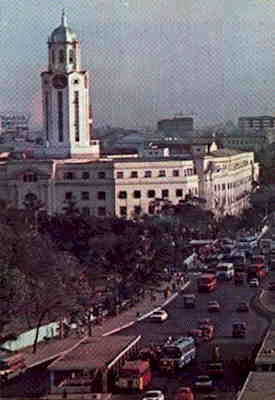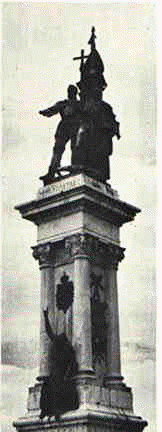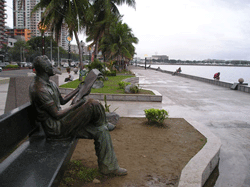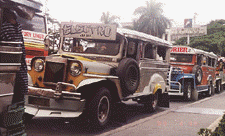Tribung
Pinoy
The
Philippines
Brief
History
Philippine
Government
The
Gateway
Economic
Profile
Arts
& Culture
Indigenous
People
Speak
Filipino
Music
& Song
Photo
Gallery
Important
Links
What's New?
Links to Philippine media
organizations, embassies & consulates,
public and private offices and organizations.
Click here
Philippine Flag
Click here
National Anthem
Click here
|
Manila
It is the gateway to many islands and peoples' destinations north
and south of the Philippines.

Manila City Hall
|
Manila is the seat
of administration and the center of commerce and industry, culture, the arts, and
education. It is the largest and most important city in the Philippines. It is a
cosmopolitan city, with a wide range of amenities for the expatriate and his family.
General living costs, including education in schools with internationally accredited
curricula, are much less expensive compared to other cities in the region. To many
expatriate families, Manila is the preferred Asian location incorporating ease of travel
with a highly acceptable lifestyle.
Other major population centers are Davao, Cebu, Zamboanga,
Bacolod, and Iloilo.
Manila began as a small tribal settlement on the banks of the
Pasig River near the mouth of Manila Bay. It took its name from a
white-flowered mangrove plant -- the nilad -- which grew in abundance in the area.
Maynilad, or where the nilad grows, was a fairly
prosperous Islamic community ruled by Rajah Sulayman, descendant of a royal Malay
family.
|

Miguel Lopez de Legaspi |
On May 24,
1570, almost 50 years after Ferdinand Magellan -- a Portuguese explorer under the service
of the King of Spain -- first set foot on these islands, a Spanish expedition under
Marshal Martin de Goiti reached Sulayman's settlement. Encountering resistance from the
Muslim king, de Goiti retaliated by burning down villages and capturing the artillery. The
following year, Spanish conquistador Miguel Lopez de Legaspi arrived at the mouth of the
Pasig River and claimed the islands in the name of the King of Spain. He established the
"distinguished and ever loyal city" of Manila, proclaiming it as the capital.
Thus began more than 300 years of the Spanish colonization of the Philippines.
The new city was encircled by double walls -- Intramuros -- and
guarded by a fort -- Fort Santiago. The Spanish kept to their enclave and net out their
missionaries and armies to conquer the countryside. In the suburbs or arabales like Tondo,
Sta Cruz, Quiapo, Sampaloc and Malate, the indios -- as the natives were called -- lived
and worked together with the mestizos (of mixed Filipino and foreign descent). The
sangleys or Chinese merchants lived in the parian, a district which became part of the
present Binondo.

Favorite place of sunset watchers |
In the 19th century, Spain's colonies were racked by corrupt
administration and internal disorder. Liberal ideologies fired the spirits of enlightened
Manilenos (resident of Manila) like Philippine national hero Jose Rizal who studied abroad
and Filipino rebel leader Andres Bonifacio who read books on revolutionaries and
philosophers. The seeds of revolution were thus sown in Philippine soil, and insurrection
sprouted all over the countryside. By the late 1800s, Spain had lost control over the
Philippines, and with her major defeat by the American fleet in the Battle of Manila Bay,
totally relinguished her hold on the colony.
But freedom would not come so easily, for the Filipinos
eventually found themselves under their erstwhile ally, the Americans. Under the new
conquerors, Manila spread outwards, roads and bridges were built, and schools taught the
Filipinos western culture and proficiency in a new language -- English. Democratic
processes were introduced; and neo-classical government edifices rose around the
old city. But the outbreak of World War II soon halted all that.
For three years, the country chafed under the Japanese
occupation. The end of the Pacific War left Manila in ruins but it also brought liberation
and independence. In July of 1946, the Commonwealth government under Manuel L. Queen
declared independence.

Locally assembled jeepney |
The post-war years saw the reconstruction of Manila and its
growth in area and population. Land was developed in areas now covered by the cities of
Makati, Mandaluyong and the municipality of San Juan. Subdivisions and residential
villages flourished in the cities Quezon, Pasig, Pasay and Paranaque. Factories and
industrial areas burgeoned in Kalookan, Malabon and Valenzuela. Adjoining municipalities
of Taguig, Pateros and cities of Las Pinas, Muntinlupa and Markina were developed and
annexed. In 1976, a conglomeration of four cities and 13 municipalities was officially
designated as Metro Manila.
Today, Metro Manila is also known as the National Capital Region
-- a thriving, ever-enlarging urban sprawl covering about 630 square kilometers and
harboring a population of about ten million.
|